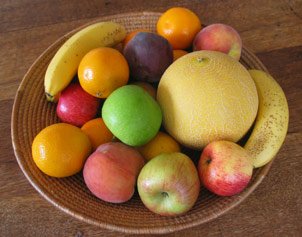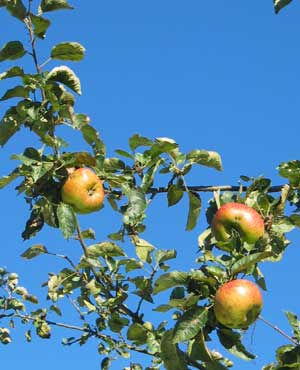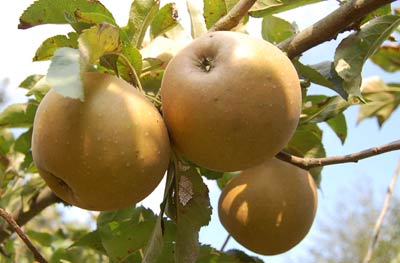Fruit Nutrition Facts
- some top fruit choices

Here are some of my top fruits -
- and some intriguing fruit nutrition facts.
There are lots of excellent and exotic fruits out there, from mangosteen to chokeberry. But here we are concentrating on fruit nutrition information about some of the commonest fruits. There is also some information about the nutritional values of different types of fruits.
You really do not have to search far to find excellent fresh fruits with valuable nutritional profiles. Just common - or garden - fresh fruits, eaten frequently will have fantastic benefits for your health.
Raw fruit is generally the most beneficial, especially if it is organic. Fruit nutrition is also valuable from quality fruit juices and dried fruits.
This page gives details of the benefits of some common fruits and looks at how to avoid the worst of the pesticides sometimes used.
Read on for fruit nutrition facts for apples, oranges, bananas and kiwi fruits.
Fruit nutrition facts - top fruits
Apples
What a pocket-rocket for good health! Apples have some surprising fruit nutrition facts in their favour and are hard to beat as a health food for on the go!
Apples are grown all around the world and if you are in a temperate region you should be able to find relatively local supplies of good fruit which can last the year round.
Apples are a good source of fibre and can be quite high in vitamin C. Their value as a snack food is legendary. Whoever coined the saying "An apple a day keeps the doctor away." was not wide of the mark!
Are there any special nutritional features of apples?
Compared to many fruits apples do not appear to shine, at least in regard to the main vitamins and minerals. You will meet just a very small percentage of your needs for Vitamins B, D, calcium and magnesium, for example. The amount of iron and folate, too is only around 1% of your needs.
However, that is without considering phytochemicals.
Sponsored links
Wonderful phytochemicals!
Apples also contain phytochemicals which act as nature's frontline against disease. Compounds such as quercetin, epicatechin, and procyanidin protect against cancers and act as antioxidants. Quercetin, for example has anti-inflammatory properties and may prevent tumor formation. It may even offer some protection against cataracts.
Proanthocyanidins such as procyanidin reduce histamine production and so reduce and prevent allergic reactions. They also prevent capillary damage and protect against strokes, heart disease, wrinkles and other signs of ageing. They even act as a natural built-in sunscreen. Apple varieties such as Red Delicious and Granny Smith are the some of the best common sources of these proanthocyanidins - better even than red wine.
Many of these phytochemicals are found elsewhere in foods, especially fruits. But what a marvellous set of attributes for such a common pocket snack! Fresh apples, eaten raw are of course the best for health.
Some not-so-wonderful chemicals in apples

Don't eat too many apple pips as they do contain a small amount of cyanide. This is a naturally occurring chemical.
It's always worth washing apples, even organic ones. If you are eating non-organic apples it is wise to avoid the skin around the stalk as pesticide residues (and dirt) may collect there. There are stringent rules governing how close to picking time apples may be sprayed.
Nevertheless, research in 2004 by Friends of the Earth showed that up to 200 children a day could be receiving more than the allowable pesticide dose from fruit eaten. This is because the amount of residue on fruit varies quite widely. This occurs even when the regulations are observed.
Chlorpyrifos is one of the commonest chemicals found as a residue in apples. It is one of PAN's "Bad actor" chemicals, i.e.it is one with many drawbacks to its use. See PAN's database for more information.
Some fruit nutrition facts:
Interesting apples
There are many interesting old apple cultivars which are worth seeking out. You should not have to eat just endless tasteless golden delicious! Many local varieties will have significantly better vitamin content than the bland supermarket varieties so often on offer.
Many old varieties are being rescued as old orchards are re-discovered and restored. A unique variety was found against a wall on Bardsey Island off the coast of Wales. You can now buy this and other rare varieties from specialist nurseries. You need to ensure the suitability for your situation, of course.
Some fruit nutrition facts about bananas
Bananas are one of the best sources of instant energy and they are really quite high in potassium.
Potassium is good for our ability to manufacture energy and balance the fluid and sodium in our cells. It is particularly important in declining health and old age.
As everyone knows, a banana is a great pocket snack, containing as it does a good amount of carbohydrate, some of it instantly accessible as fruit sugars. Bananas are also a great source of vitamin B6, a vitamin which plays a host of roles in metabolism. B6 is found in meat and dairy foods but it degrades with cooking, so raw fresh bananas offer a good source. They can supply over a quarter of our daily needs for this vitamin. B6 may have a role in treating autism and Parkinson's disease. It is also very useful for dispelling a hangover!
There are problems with taking vitamin B6 supplements so it is best to get your needs met through natural sources. Bananas fit the bill nicely. The B6 present in them may also help women suffering from morning sickness.
Bananas are imported by ship into non-tropical counties such as Britain and Germany. This trade is not as sustainable as some but it is hard to imagine a more temperate replacement for the banana. Apples are fantastic pocket fruits, of course, but they are rarely as filling as a good ripe banana.
Some fruit nutrition facts:
Organic and fair trade bananas
More and more bananas are being grown under fair trade schemes. The co-op in Britain now has almost all fair trade bananas and they are widely available elsewhere.
Buy organic if you can; there are far fewer toxic residues to worry about and the agricultural methods used should benefit all, including local wildlife.
Most workers in non-organic schemes receive low pay for long working hours while being exposed to highly toxic pesticides.
You can learn about bananas in the Caribbean and the political issues of surrounding the globalization of food from this ground-breaking book by Lawrence S. Grossman.
Doleorganic.com does an organic programme which appears to look after its workers. They are a US firm operating in South and Central America.
Some fruit nutrition facts:
Commercial pressures... and the "Goldfinger"
The very existence of the commonest kinds of banana could be under threat because of commercial pressures. Common cultivars such as the "Cavendish" are susceptible to disease because of lack of genetic diversity.
Growers like the uniformity of product which can be achieved when a single type is used but Cavendish bananas are now succumbing to Panama Disease, a fungal infection. Up until the 1960s the favoured type was "Gros Michel". It became subject to Panama Disease and so growers switched to the Cavendish, which was supposed to be more resistant.
This would seem to be a good argument for far more genetic diversity in the bananas grown. Unfortunately many of the alternatives have rather different characteristics, which can lead people to reject them as foodstuffs.
More fruit nutrition facts - bananas can be bred successfully without the need for any GM technology. There are fears that GM methods can have unintended consequences, maybe even affecting the nutritional value of the fruit and other foods grown by those methods. Certainly the increased yields, much touted as good reasons for using GM methods, have been shown to be fairly unsubstantiated. (See this article from The Independent.)
Work is ongoing in Honduras on hybrid bananas to find better options for the future. The "Goldfinger" banana can grow in cooler climates and is bred to be pest-resistant. It was done using a wide gene pool and conventional hybridization methods - not genetic modification.
Sponsored links
Some fruit nutrition facts:
Kiwi fruit
Kiwi fruit are sometimes called Chinese gooseberries. They are farmed all around the world, Italy now being the top producer. Many kiwis in the UK supermarkets are imported from Chile. There are now organic ones available from New Zealand and Chile, Italy and California.
Organic fruit may be slightly smaller on average than conventionally grown fruit. Kiwis are relatively easy to grow organically, as there are not too many pests and diseases which threaten crops.
An IPM (Integrated Pest Management) system called 'KiwiGreen' is used by growers in New Zealand which is fairly effective but improvements are always being sought.
They are the most fantastic source of vitamin C. Expect to obtain around 150 grams or more per fruit. Two kiwis will supply you with as much potassium as a banana and twice as much vitamin C as an orange. For this reason it has been called a superfood. (See SuperFoods HealthStyle: Simple Changes to Get the Most Out of Life for the Rest of Your Life by Dr Stephen Pratt.)
Some more fruit nutrition facts regarding kiwis: they are also a good source of Vitamin A, Vitamin E and fibre. A study by Rutgers University called it one of the most "nutrient dense" foods.
Please see Fresh Fruit Salad Recipes for some ideas for how to use kiwi fruits.
Some fruit nutrition facts:
Why choose organic kiwis?
Organic kiwis are safer for young children (and anyone, really) as there are far fewer chemical residues to worry about.
A bud-breaking chemical is used by conventional growers. It is both toxic and visible, so many people are becoming more aware of the advantages of organic kiwi fruit.
Bud-breaking chemicals are used to help fruit form regardless of when weather conditions are exactly right, so they save producers money and enable them to have a consistent harvest.
Some fruit nutrition facts:
Kiwis supplant the vine
Many Italian farmers are abandoning the traditional grapevines for kiwi growing as it is seen as more profitable. From a green perspective this is not so great, as kiwis demand three times as much water input as vines.
Read on below the ads for fruit nutrition facts for oranges.
Some fruit nutrition facts:
Oranges
Oranges are a great source of vitamin C. You can expect to get about 60 - 70 mg from a fresh medium sized orange. They also contain useful amounts of potassium (200mg or more), vitamin A and vitamin E. There are some B vitamins, too and a number of minerals including small amounts of iron, calcium and magnesium.
They have other attractive properties. The bioflavonoids, which are co-agents for vitamin C, help fight off cancers, as do the beta-carotenes which help us manufacture vitamin A in our bodies. There are other useful "phytochemicals" - active agents with a range of health benefits. Phytochemicals can help to protect us against heart disease.
Oranges are grown all around the world so the chances are you are not too far from a production area, no matter where you live.
Like any food, the quality of your oranges will deteriorate the longer you store them. Keep them in the fridge for best maintenance of the vitamins and other nutrients. They should keep for two or three weeks or longer.
Richer organic oranges
A study conducted by the American Chemical Society in 2002 found that organic oranges, although typically smaller than conventionally grown ones, were up to 30% richer in vitamin C.
Conventional growers use cyfluthrin to combat citrus thrips, insects which damage the outer skin, making the fruit look less perfect. In fact, the damage to the orange is largely cosmetic but oranges with thrip damage command a lower price at market. Ironically, the chemicals which kill the thrips also kill most of their predators.
Organic orange growers typically have grasses or other plants growing between the trees, making a more complex and interdependent eco-system. Rich organic mulches and foliar feeds (compost teas) mean that problems such as thrips rarely get out of hand.
Such fruit nutrition facts as those mentioned above are yet more strong arguments in favour of a permaculture approach to fruit growing. Fruit growers who use organic and permaculture methods are likely to grow crops which are both disease resistant and nutritious.
There are more fruit nutrition facts detailed in the nutritional value of fruit.
Return from Fruit Nutrition Facts back to Green Kitchen - Natural and Organic Foods
Greenfootsteps Home - for more easy green living ideas
| Tweet |

| Tweet |

On other pages:
Growing apples at home is rewarding
Sponsored links
Footprints
- an occasional e-zine from Greenfootsteps
If you would like to receive the e-zine, please just sign up below.







New! Comments
Have your say about what you just read! Leave me a comment in the box below.